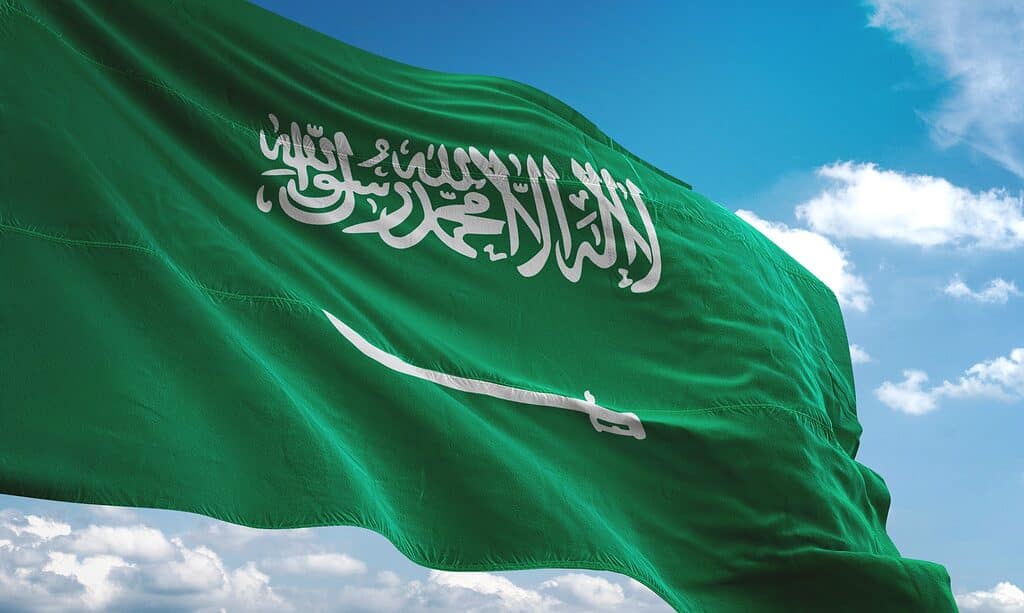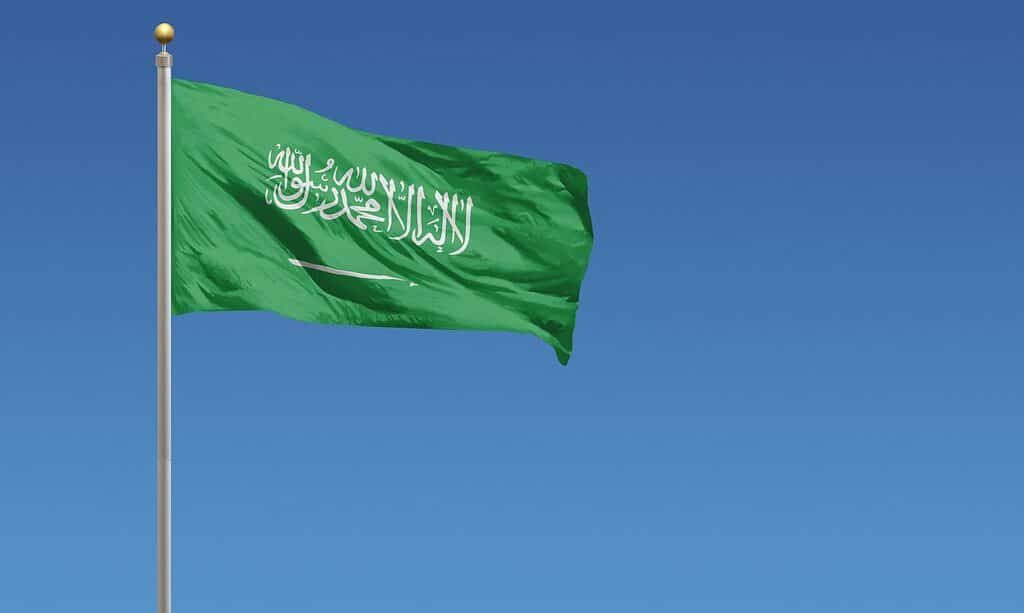What do you picture when you think of Saudi Arabia? Is it the vast, scorching hot desert? The humped camels ridden by men in all-white robes? Or do you think of Aladdin and his magic carpet swiftly flying over the colorful towns and pungent smells of flavorful spices? Countries from different parts of the world boast various kinds of culture, and those from the Middle East are remarkable and unforgettable, to say the least.
Arabian horses, the biggest sand desert in the world, the holy sites of Mecca and Medina, the world’s widest oasis (Al Ahsa), Arabian coffee, oil, a myriad of palaces, and numerous mosques are some of the things that make Saudi Arabia unique. Moreover, Saudi Arabia is the largest country in the world without a river. But another thing that defines this Arab nation is its simple yet recognizable flag. So, what is the meaning and symbolism behind its simplicity? This article uncovers the history of the flag of Saudi Arabia and more!
Introduction to the Flag of Saudi Arabia
Since March 15th, 1973, the Saudi Arabian government has flown the flag of the Kingdom of Saudi Arabia. It flies a green flag with a sword and Arabic text in white. The inscription, Islamic creed, or Shahada, states that Muhammad is God’s Messenger and that there is no other god.
Although Saudi Arabia is young, its flag has four different designs. In some ways, the history of Saudi Arabia’s flags is the history of the country’s forebears, as they influenced past flags employed for the same purpose.
Design and Symbolism of the Flag of the Kingdom of Saudi Arabia

The nation’s Islamic heritage is depicted in the inscription on the flag, which is further exemplified by the green field.
©iStock.com/Derek Brumby
The Saudi flag features a white sword and text on a solid green background. The Shahada, the Islamic creed, is written on the flag. In Arabic characters, they say: لَا إِلٰهَ إِلَّا الله مُحَمَّدٌ رَسُولُ الله or “lā ʾilāha ʾillā-llāh, muhammadun rasūlu-llāh” which translates to “There is no deity but God; Muhammad is the Messenger of God.”
The nation’s Islamic heritage is depicted in the inscription, which is further exemplified by the green field. The country’s relationship with the Wahhabi movement is also implied in the text. The flag is made with equal obverse and verso sides to ensure that the Shahada can be read accurately from either side. Both sides of the blade also point in the direction of the script, which is to the left.
The color green said to have been the Prophet Muhammad’s favorite, represents Islam and can be seen on the flags of many Muslim countries, such as Iran, Algeria, and Pakistan. Islam is symbolized by the flag’s green color, while the sword depicts the strictness with which justice is administered. The royal house of Saud, which created the nation, is symbolized by the white sword and stands for the country’s military might.
The color used on the nation’s flag at the United Nations is Pantone 349, while Pantone 355 was utilized at the 2012 London Olympics. Still, the typical color of the flag’s green was estimated by Album des pavilions as Pantone 330 C. The flag is flown toward the left-hand side of the flagpole, as viewed from the obverse (front) side.
History of the Flag of Saudi Arabia
The flag of Saudi Arabia is very similar to Nejd, a state precursor to Saudi Arabia. The green field on the flag of Nejd, which was in use from 1921 to 1926, was identical to that on the flag of Saudi Arabia and was a feature of many Islamic countries. It also included a white sword and the Islamic creed, but in contrast to the Saudi flag, the inscription and emblem were much larger, and the sword was facing the other way. From 1926 to 1932, Nejd flew a separate flag that lacked the sword and had a white border.
The design of the country’s flag was inspired by Saudi Arabia’s founder, Abdulaziz Al-Saud. The Al Saud commander Abdulaziz Abdulrahman Al-Saud, who would go on to form the Kingdom of Saudi Arabia, embellished this flag with a sword in 1921. Prior to March 15th, 1973, the flag’s design was not standardized, and variations with two swords and/or a white vertical stripe at the peak were often used.
The first version of the flag, which had a white stripe and a slightly modified sword motif, was adopted in 1932. The white stripe was gradually reduced in size and eliminated in later iterations. By 1938, the flag had essentially taken on its current appearance, excluding the sword, which had a different design (a more bent blade) and occupied a larger portion of the flag’s area along with the Shahada above. The most recent version, which the Saudi Arabian government accepted in 1973, modified the flag by reshaping the sword.
Usage of the Saudi Arabian Flag

It is prohibited in Saudi Arabia to hoist the flag vertically.
©iStock.com/Oleksii Liskonih
The law in Saudi Arabia prohibits raising the standard flag vertically. It is possible to buy specialized vertical flags that spin the inscription (the creed) and the insignia (the sword), but this is uncommon because most Arab nations don’t usually fly their flags vertically.
It is customary to avoid using the flag on T-shirts and other goods because the Shahada is revered as a holy text. Saudi Arabia objected to being included on a FIFA football that featured all participating nations’ flags from the 2002 FIFA World Cup. According to Saudi officials, kicking the creed with your foot was entirely inappropriate. Similar to this, an effort by the United States military to win over Afghan children in the Khost Province by giving out footballs decorated with flags, including the Saudi Arabian flag, resulted in protests.
Up Next:
3 Countries With Animals on Their Flags, and Their Meaning
The ‘Join, or Die’ Flag vs. ‘Don’t Tread on Me’ Compared. History, Meaning, and More
The 10 Countries With Stars On Their Flags, and Their Meaning
The Flag of Portugal: History, Meaning, and Symbolism
The photo featured at the top of this post is © iStock.com/daboost
Sources
- , Available here: https://en.wikipedia.org/wiki/Flag_of_Saudi_Arabia
- Whitney Smith, Available here: https://www.britannica.com/topic/flag-of-Saudi-Arabia
- , Available here: https://www.gettysburgflag.com/flags-banners/saudi-arabia-flags
Thank you for reading! Have some feedback for us? Contact the AZ Animals editorial team.






